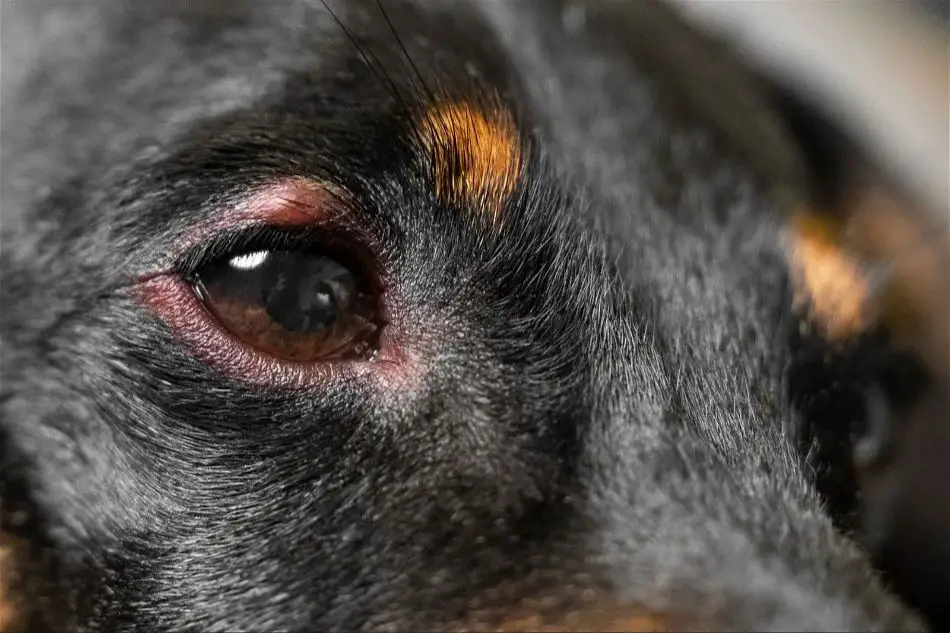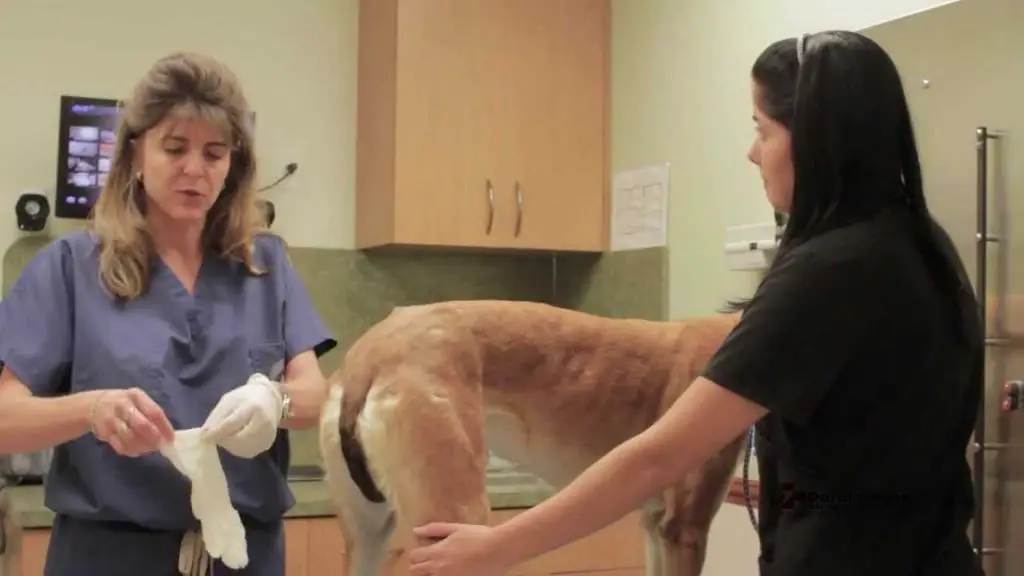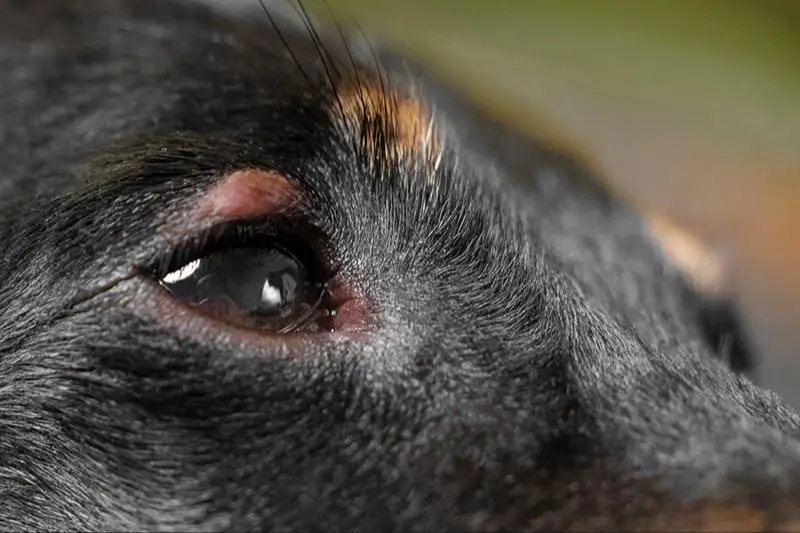What is a Stye?
A stye is a tender, red bump that develops on the inside or outside of a dog’s eyelid. Styes are caused by an infection of the oil glands at the base of the eyelashes. They typically form when bacteria or dirt block one of these glands, leading to an accumulation of pus and inflammation.
In dogs, styes most often develop on the inner surface of the upper eyelid near the nose. However, they can also occasionally form on the lower lid. Common symptoms of a stye include:
- Swollen, red bump on the eyelid
- Excessive tearing or discharge from the eye
- Squinting or keeping the eye closed
- Rubbing or pawing at the irritated eye
- Apparent discomfort, pain, or irritation in the eye
While styes may look like a small pimple on the surface of the eyelid, the infection actually originates from deeper within the oil gland. If left untreated, the bump can continue to grow and the infection can spread.
Do Styes Hurt Dogs?
Styes can cause mild to moderate pain and discomfort in dogs, similar to what humans experience with styes. The level of pain depends on the severity of the inflammation and infection.

Like in people, styes in dogs are tender to the touch. Dogs may squint or keep their eyes shut to avoid rubbing or irritating the stye. There may be excessive tearing as well as sensitivity to light.
Styes can feel like having a foreign object or gritty irritation in the eye. The swelling puts pressure on the eye tissue, causing a dull ache or soreness. Dogs may paw at their eyes repetitively due to the discomfort.
In severe cases, a stye can cause more intense throbbing pain. However, most mild styes result in minor irritation for a dog rather than substantial pain.
While styes are uncomfortable, they are not as painful as some other eye conditions like glaucoma or uveitis, which can cause severe ocular pain and headaches.
Overall, styes can hurt dogs to a mild-moderate degree, similar to the irritation and soreness they produce in human eyes. Keeping the eyes clean and treating the stye is important to minimize a dog’s discomfort.
What Causes a Stye?
A stye in dogs is typically caused by a bacterial infection or a blocked oil gland on the eyelid. The most common bacteria implicated in styes is Staphylococcus.
When bacteria multiply in the oil glands on the eyelids, it can lead to inflammation and swelling of the gland, forming a small pimple or pustule – the stye. If the opening of the gland becomes clogged with oil, debris, or dead skin cells, this also provides a breeding ground for bacteria.
Certain dog breeds are more prone to developing styes. Breeds with prominent or bulbous eyes like Pugs, Pekingese, Bulldogs, and Shih Tzus tend to be predisposed. Their eyelids turn inward, allowing oils and bacteria to accumulate more easily.
Treating a Dog’s Stye
If your dog has a stye, treatment may include:
Warm Compresses

Applying a warm, wet washcloth to the affected eye can help relieve swelling and discomfort. Do this for 5-10 minutes, 2-3 times a day. The warmth helps draw the stye to a head so it can drain.
Antibiotics
Your vet may prescribe antibiotic eye drops or ointment to treat the infection causing the stye. It’s important to use the medication as directed and finish the entire course, even if the stye seems to go away.
Steroid Eye Drops
Steroid eye drops like dexamethasone can help reduce inflammation and irritation from the stye. Always follow your vet’s instructions on how often and how long to use them.
Surgery
In rare cases, a stubborn stye that does not respond to other treatments may need to be surgically drained or removed. This is usually done with local anesthesia. Most dogs recover fully within a few days.
Home Remedies
There are some simple home remedies that can help soothe a dog’s stye and promote healing. Natural ingredients like chamomile, aloe vera, and colloidal silver have anti-inflammatory and antimicrobial properties that can provide relief.
Applying a chamomile tea bag to the affected eye can help reduce swelling and irritation. Chamomile contains compounds like bisabolol that have soothing effects. Steep a chamomile tea bag in hot water for a few minutes. Allow it to cool and then apply to the stye for 5-10 minutes, 2-3 times per day.
Aloe vera gel is another great option. It contains phytochemicals that reduce inflammation. Apply a small amount of pure aloe gel to the stye 2-3 times daily. The cooling gel can ease discomfort.

Colloidal silver is a suspension of silver particles in liquid. It has antimicrobial effects and can fight infection. Use a cotton pad to apply a diluted colloidal silver solution on the stye 2-3 times a day. This may help clear up the infection faster.
Along with these remedies, keep the area around the eye clean. Use a warm, wet cloth to gently wipe away any discharge or crusting. This can prevent worsening of the stye.
Preventing Future Styes
There are a few things you can do to help prevent future styes from developing in your dog:
Keeping eyes clean – Make sure to gently wipe your dog’s eyes daily with a warm, damp cloth to remove any discharge or debris. This helps prevent bacteria from building up around the eyelids and eyelashes.
Treating underlying eye issues – If your dog has an underlying condition like dry eye or allergies, properly managing these conditions can reduce irritation and inflammation around the eyes. This makes styes less likely to occur.
Monitoring for blocked glands – Check your dog’s eyelids and eyelashes regularly for any blocked meibomian glands. Gently massaging the eyelids can help express the glands and prevent blockages that could lead to styes.
With proactive eye care and addressing any underlying issues, you can help lower your dog’s chances of developing those painful styes in the future.
When to See the Vet
While styes are typically harmless, there are some situations where you may need to take your dog to see the vet:
- The stye doesn’t seem to be improving within a week or so.
- Your dog develops multiple styes at once.
- Your dog seems to be in a lot of pain or is rubbing their eye excessively.
If any of these occur, it’s best to have your vet take a look. They can examine your dog’s eye closely and determine if medication is needed. Styes that don’t heal can lead to more serious eye infections. Your vet may prescribe antibiotic eye drops or ointment to help clear up stubborn styes.
Seeing the vet promptly when a stye persists can help prevent complications and relieve your dog’s discomfort. Don’t wait too long before seeking veterinary care if your dog’s stye isn’t getting better.
Risk Factors
Certain dogs are more prone to developing styes than others. Some of the main risk factors include:
Breed Predisposition
Some breeds are more likely to get styes, including Pekingese, Shih Tzus, Lhasa Apsos, Bulldogs, Setters, Retrievers, and Cocker Spaniels. Their physical features like prominent eyes and sagging facial skin increase the risk.
Allergies or Eye Irritation

Dogs with allergies or other sources of eye irritation like dry eye or eyelid abnormalities tend to be more susceptible to styes. The inflammation and rubbing can allow bacteria to enter and infect the oil gland.
Eyelid Abnormalities
Structural issues with the eyelids can raise the chances of developing a stye. Entropion, ectropion, and distichiasis involve the eyelids rolling in, out, or containing extra eyelashes which can cause irritation and infection.
Prognosis
The prognosis for most styes in dogs is good. With proper treatment, most styes will resolve on their own within 1-2 weeks. However, styes can recur, especially if the underlying cause is not addressed. While styes may be uncomfortable for dogs, they are not usually vision threatening. As long as the stye is monitored and treated as needed, complete healing is expected.
In rare cases, a severe, untreated stye could potentially lead to complications like corneal ulcers or vision loss. But with veterinary attention and following treatment recommendations, this outcome is unlikely. Just keep an eye on the stye and follow up with the vet if it persists beyond a couple weeks or seems to be getting worse. With appropriate care, a stye should clear up without any long-term effects on your dog’s eye health or vision.
Summary
To recap the main points, styes are fairly common in dogs and can cause some pain and irritation. Styes are caused by bacterial infections of the oil glands in the eyelids. While styes often resolve on their own, there are some home remedies like warm compresses that can help speed healing. To prevent styes, keeping your dog’s face and eyes clean is key. See your vet promptly if the stye doesn’t improve within a few days or if your dog seems in a lot of discomfort. Overall, styes are treatable and prevention is possible with good hygiene.